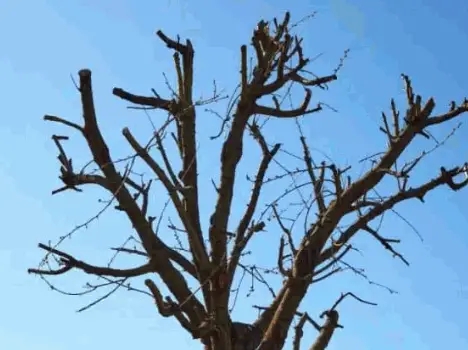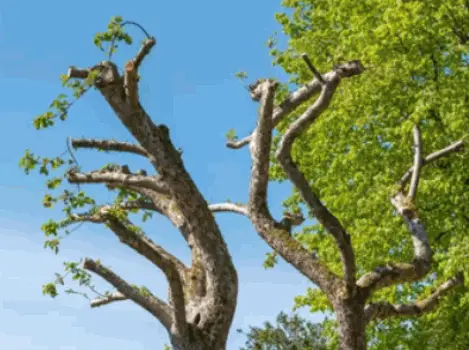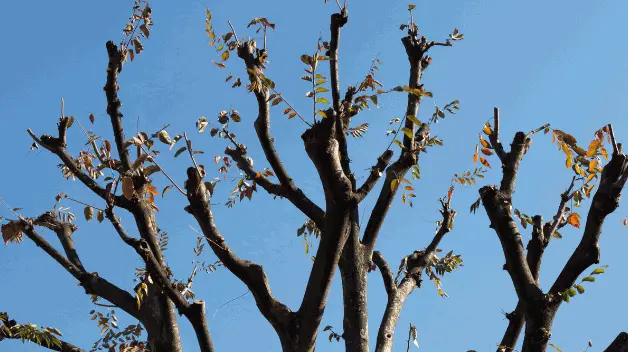No matter how green-fingered you are, it’s likely that you’ve done this at some time; you’re enthusiastically lopping and cropping back unwanted growth and dead branches and suddenly you realise that you’ve taken off too much.
Of course, you might have moved house and acquired a new garden with a badly pruned tree or two, and you need advice.
If you or someone else has over-pruned a tree, don’t despair! It may be that all is not lost. First, this has happened to the best gardeners and horticulturalists, amateur or professional (yes, even me, Equipment Girl!) however much they may deny it. Second, there may be something you can do about it.
Why Is Over-Pruning Trees A Problem?
Over-pruning a tree can be a costly mistake: it can weaken the tree and make it more susceptible to disease, pathogens and pests, which can be fatal.
When tree branches are pruned too harshly, they are often no longer able to cope with ice loads or high winds, potentially causing them to break off.
Pruning trees also removes many of the leaves it relies on for nutrition (water and minerals come through the roots, but the leaves draw CO2 from the atmosphere and turn sunlight into food via photosynthesis). So, when you over-prune a tree regularly it channels all of its efforts into replenishing its canopy. This is bad, as it can seriously disfigure the tree and expose it to too much sunlight; the tree’s canopy acts as a shade that stops the tree from being scorched.
Eventually, the tree becomes exhausted from the effects of the sun and lack of nutrition. Its natural defences are weakened and it will become sick, and maybe even die.
However, there are a few tricks that might help to revive the tree or at least stop it from becoming worse – unless the damage is too great.

How To Fix An Over-Pruned Tree
So, you think you’ve taken off far too much while pruning. What can you do about it?
The first thing to do is to confirm whether you’ve actually over-pruned or not. But how do you tell? Here’s the Equipment Girl step-by-step guide to fixing an over-pruned tree.
What Does An Over-Pruned Tree Look Like?
Over-pruned trees will look stressed. Think about it this way: every time you cut a branch you create an open wound. The more you cut back, and the more severely you cut, the more wounds the tree has. These will bleed sap for a while – all woody plants have
If you cut off all the branches leaving only the central trunk left standing, you’ll have one severely stressed tree!
Check out: Best Tools To Cut Tree Branches

Water Sprouts
One of the first signs of heavy over-pruning is the appearance of water sprouts. These tiny shoots appear from dormant buds on the trunk or branches of mature trees, usually as a result of drought or injury, and they are part of the tree’s natural healing process; the tree is trying to grow new branches to keep itself healthy. If left long enough, these form long, spindly shoots around the injury.
These often appear at the base of the trunk, although they are usually called suckers, in this case.
A topped tree will almost always put out suckers and water sprouts as a way of defending itself. Tree topping involves cutting off the main trunk and upper branches, usually when it’s thought that the tree has grown too high and presents a hazard, often when it is close to a building. Removing the tree canopy without damaging or killing the whole tree requires skill and should, ideally, be performed by professionals.
Some topped trees, such as certain types of conifer, will never grow back, so take note of this before heading out with those pruning shears!
Disease
Too much pruning can make a tree susceptible to various diseases, and the type of disease often depends on the tree species.
For example, laburnums, cherry trees, rhododendrons and poplars are all at risk of silver-leaf disease. Bacterial canker affects a lot of fruit tree varieties, and witches’ broom* is frequently seen on stressed-out silver birch trees.
*This appears as a dense bunch of wiry twigs resembling a bird’s nest.
Lack Of New Growth
Springtime is when trees and plants burst into life, but a heavily pruned tree will be slow to respond to the returning light and warmth. This applies to fruit as well as leaves and blossom, as the tree will put its energy into growing more new wood rather than anything else.
Check out: Sun Leaves Vs Shade Leaves
Broken Branches
You’ll probably notice that more branches come down in the wind or when ice forms on them in winter. This is because the tree is weakened and can’t cope with extra stress.
Deformity
Poor pruning can throw a tree out of balance. The leader is the main branch from which the others grow, and if this is pruned back on young trees (particularly deciduous trees), it can cause problems. Once this is cut, competing branches will try to take over! So-called double-leaders can grow, resulting in bark inclusion.
This is where the two (or more) trunks grow too close together in a V-shape or bark-included junction. This is bad news, as the joint is usually fairly weak, meaning that it might fail at some time. Trees can provide their own solution in the form of a ‘natural brace’, where branches cross over to support each other, but this isn’t always the case.
Damage Assessment
The first step towards getting a healthy tree is to assess the damage. How much of the tree was pruned? Were any major branches removed? If the tree was severely over-pruned, it might not be able to recover. Sadly, in some cases, the only option may be to remove the tree as it will die before long.
Alternatively, if it is beyond rescue and isn’t likely to cause any hazards, you can leave it in place: a dead tree can be a fantastic way of encouraging wildlife as it provides a habitat for a multitude of flora and fauna.
A lot depends on how recently the drastic over-pruning took place, and how regularly it has been happening. If you inherited a badly pruned tree (or trees) with all its branches cut off, then it might be too late – but don’t give up just yet!
Caring For Your Over-Pruned Tree
In all honesty, time is the only real cure. But then, patience and planning are what gardening is all about!
Even so, there are a few things you can try in order to save your tree and nurse it back to full health once again:

Regular Watering
Assuming that the tree is salvageable, the next step is to provide it with the care it needs to recover. Water it deeply and regularly, especially during dry periods. ‘Deep watering’ is a great idea – leave a hose on a very low trickle and lay it at the base of the tree for a couple of hours. Alternatively, drill several small holes in a large bucket, fill it with water and let it drain slowly into the ground. This provides a manageable supply of water to the roots without swamping the roots.
If you’re concerned about your water use (or there’s a hosepipe ban in your area), you can use grey water (from baths, showers or washing up, but NOT your dishwasher) or invest in a water butt.
Fertilize It Well
Provide proper fertilization according to the instructions on the product label, and protect the tree from pests and diseases as far as practical. Look for a good brand fertilizer with a 2-1-1 or 3-1-1 ratio of nitrogen, phosphorous and potassium, as this is the best mix for trees.
Wound Dressing
Dressing wounds on trees is a thorny issue! Most tree experts believe that you should let the wounds heal naturally by themselves, and this is generally great advice. Dressing an open wound on a badly-pruned tree can seal in the decay, bacteria and moisture, which will only add to your problems and slow down the healing process.
Trees have spent thousands of years developing a system that lets them compartmentalise the area around any damage. Special cells form a callus that grows around the wound to stop bugs, bacteria, diseases and fungus getting in. It doesn’t always work – it depends on the extent of the damage and how healthy the tree is – but it’s generally effective.
One thing is for sure: you should never apply tar, asphalt, paint or any petroleum-based products.
On the whole, it’s best to leave the tree to sort out the problem itself, and there are only a few exceptions to this rule. For example, oak wilt disease can affect oak trees that have fallen victim to hard pruning in spring or summer, so you might want to apply a suitable tree wound dressing. Elms may also benefit from this under similar circumstances.
Be Patient!
Don’t attack those water sprouts too soon – watch them to see how they grow and snip off any weak ones. The healthy ones will help your tree to recover as they produce the vital energy needed for recovery. If possible, wait until your tree reaches its original height then assess whether any of this growth really needs to be cut.
With time and care, your over-pruned tree may recover. Be warned, though, there’s a chance that it may never be as healthy or as vigorous as it was before it was over-pruned. It really depends on how bad the damage is. Healthy plants have a greater chance of recovery, so if you’ve looked after it until now, you’ll probably see your tree bounce back in due course.
Why Do We Prune Trees?
Tree pruning is important for several reasons:
Plant Health
Pruning trees gets rid of dead or diseased branches. These can hinder the new growth of healthy branches.
Making A Healthy Tree
Taking away sickly branches prevents disease from spreading further into the tree trunk and affecting other branches. Opening up the rest of the tree to sunlight and air also helps to keep it healthy.
Encourages Fruit Production
Pruning dead or diseased branches from fruit trees encourages more fruit to grow the following year.
Health & Safety
Practically speaking, you don’t want branches falling on people, possessions or property! Cutting these off reduces the chance of a nasty incident – and a potential lawsuit.
Check out: Best Tool For Cutting Small Trees
Aesthetics
As well as looking after your tree’s health, pruning a tree’s branches helps to create a nice shape. It can also remove obstacles to a lovely view from your window.

Advice For Future Pruning
To help you avoid common pruning mistakes, here’s some additional advice that I learned the hard way!
- Learn more about trees. The more you know about different species, the better equipped you will be to deal with any problems. Each species responds differently to pruning, so it’s best to be prepared.
- Respect The Natural Form. Try to allow the plant to flourish naturally and only remove whole branches if it’s really necessary. Never trim more than a quarter of the tree’s canopy in any pruning session!
- Prune only when necessary. The best way to avoid over-pruning is to prune only when necessary. Only remove dead, diseased, or damaged branches. If you are tree topping, make sure to cut away any lateral branch or any unruly branches that try to take the place of the leader or they will affect the tree’s structural integrity.
- Prune correctly. When you prune, make sure to do it correctly. Use sharp, clean pruning shears to make clean cuts. Avoid making flush cuts, which can damage the tree, and don’t cut too close to the bark. If you are removing a whole branch, look for the branch collar – the shoulder of the branch that has a thick growth, often with ridges running around where the branch meets with the main trunk. Make the cut beyond this, as the collar contains all the chemicals needed to protect the tree from damage and disease.
- Prune in the right season. The best time to prune most trees is in the late winter or early spring, before the buds start to swell. This will give the tree time to heal before the growing season begins.
- Get professional help if needed. Don’t be proud – if you’re still not sure how to prune your tree, or if you’ve over-pruned it and you’re worried that your tree is sick or dying, it’s best to consult with a professional arborist or local tree service. They can help you assess the damage and recommend the best course of treatment.
I’ve spent a great deal of time pruning trees and, in the early days, had my share of bad pruning. That’s why I feel qualified to give you the benefit of my experience to save you from frustration and disappointment!
By following these tips, you can help your trees to thrive and reduce the risk of over-pruning in the future.

